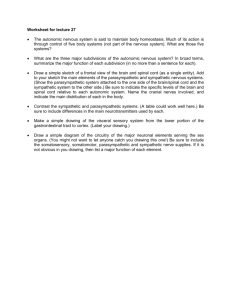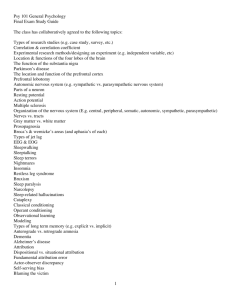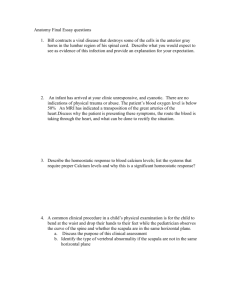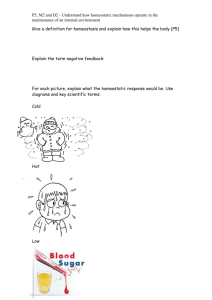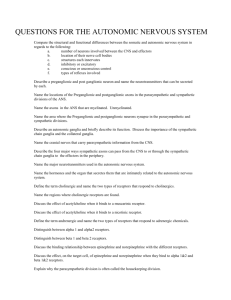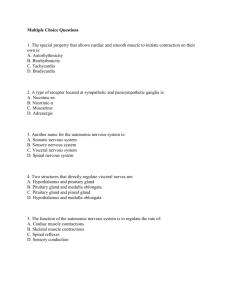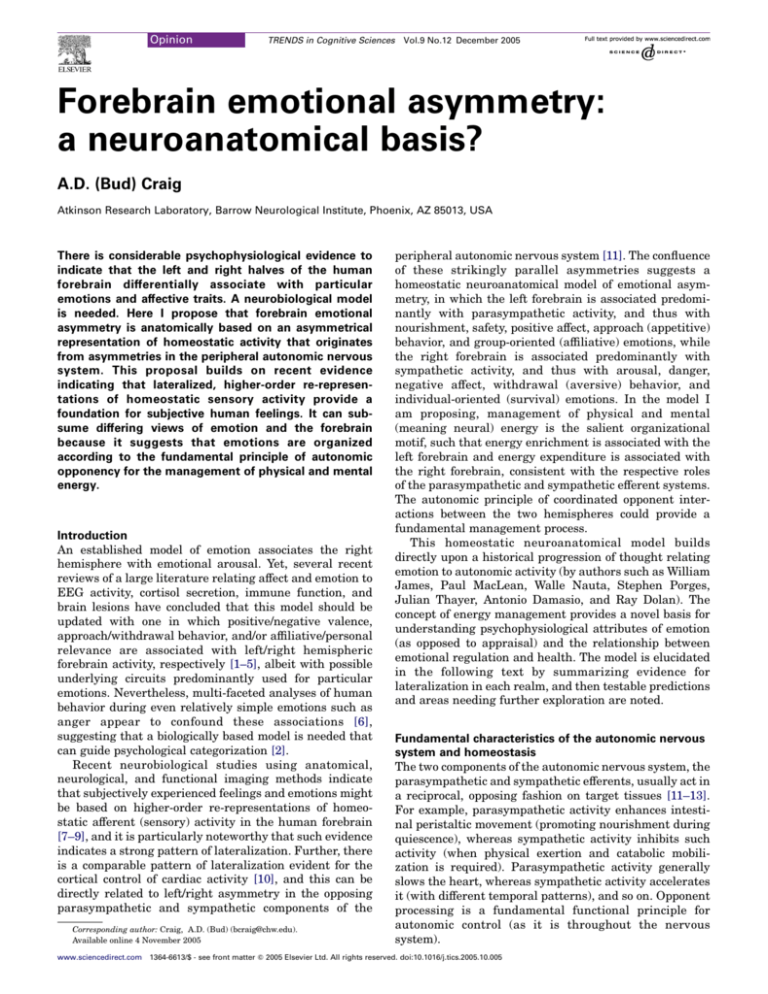
Opinion
TRENDS in Cognitive Sciences
Vol.9 No.12 December 2005
Forebrain emotional asymmetry:
a neuroanatomical basis?
A.D. (Bud) Craig
Atkinson Research Laboratory, Barrow Neurological Institute, Phoenix, AZ 85013, USA
There is considerable psychophysiological evidence to
indicate that the left and right halves of the human
forebrain differentially associate with particular
emotions and affective traits. A neurobiological model
is needed. Here I propose that forebrain emotional
asymmetry is anatomically based on an asymmetrical
representation of homeostatic activity that originates
from asymmetries in the peripheral autonomic nervous
system. This proposal builds on recent evidence
indicating that lateralized, higher-order re-representations of homeostatic sensory activity provide a
foundation for subjective human feelings. It can subsume differing views of emotion and the forebrain
because it suggests that emotions are organized
according to the fundamental principle of autonomic
opponency for the management of physical and mental
energy.
Introduction
An established model of emotion associates the right
hemisphere with emotional arousal. Yet, several recent
reviews of a large literature relating affect and emotion to
EEG activity, cortisol secretion, immune function, and
brain lesions have concluded that this model should be
updated with one in which positive/negative valence,
approach/withdrawal behavior, and/or affiliative/personal
relevance are associated with left/right hemispheric
forebrain activity, respectively [1–5], albeit with possible
underlying circuits predominantly used for particular
emotions. Nevertheless, multi-faceted analyses of human
behavior during even relatively simple emotions such as
anger appear to confound these associations [6],
suggesting that a biologically based model is needed that
can guide psychological categorization [2].
Recent neurobiological studies using anatomical,
neurological, and functional imaging methods indicate
that subjectively experienced feelings and emotions might
be based on higher-order re-representations of homeostatic afferent (sensory) activity in the human forebrain
[7–9], and it is particularly noteworthy that such evidence
indicates a strong pattern of lateralization. Further, there
is a comparable pattern of lateralization evident for the
cortical control of cardiac activity [10], and this can be
directly related to left/right asymmetry in the opposing
parasympathetic and sympathetic components of the
Corresponding author: Craig, A.D. (Bud) (bcraig@chw.edu).
Available online 4 November 2005
peripheral autonomic nervous system [11]. The confluence
of these strikingly parallel asymmetries suggests a
homeostatic neuroanatomical model of emotional asymmetry, in which the left forebrain is associated predominantly with parasympathetic activity, and thus with
nourishment, safety, positive affect, approach (appetitive)
behavior, and group-oriented (affiliative) emotions, while
the right forebrain is associated predominantly with
sympathetic activity, and thus with arousal, danger,
negative affect, withdrawal (aversive) behavior, and
individual-oriented (survival) emotions. In the model I
am proposing, management of physical and mental
(meaning neural) energy is the salient organizational
motif, such that energy enrichment is associated with the
left forebrain and energy expenditure is associated with
the right forebrain, consistent with the respective roles
of the parasympathetic and sympathetic efferent systems.
The autonomic principle of coordinated opponent interactions between the two hemispheres could provide a
fundamental management process.
This homeostatic neuroanatomical model builds
directly upon a historical progression of thought relating
emotion to autonomic activity (by authors such as William
James, Paul MacLean, Walle Nauta, Stephen Porges,
Julian Thayer, Antonio Damasio, and Ray Dolan). The
concept of energy management provides a novel basis for
understanding psychophysiological attributes of emotion
(as opposed to appraisal) and the relationship between
emotional regulation and health. The model is elucidated
in the following text by summarizing evidence for
lateralization in each realm, and then testable predictions
and areas needing further exploration are noted.
Fundamental characteristics of the autonomic nervous
system and homeostasis
The two components of the autonomic nervous system, the
parasympathetic and sympathetic efferents, usually act in
a reciprocal, opposing fashion on target tissues [11–13].
For example, parasympathetic activity enhances intestinal peristaltic movement (promoting nourishment during
quiescence), whereas sympathetic activity inhibits such
activity (when physical exertion and catabolic mobilization is required). Parasympathetic activity generally
slows the heart, whereas sympathetic activity accelerates
it (with different temporal patterns), and so on. Opponent
processing is a fundamental functional principle for
autonomic control (as it is throughout the nervous
system).
www.sciencedirect.com 1364-6613/$ - see front matter Q 2005 Elsevier Ltd. All rights reserved. doi:10.1016/j.tics.2005.10.005
Opinion
TRENDS in Cognitive Sciences
The parasympathetic and sympathetic nerves contain
both efferent and afferent fibers. Together with smalldiameter somatic afferent fibers that innervate all tissues
of the body, these nerve fibers subserve homeostasis [8],
which is the ongoing dynamic, heirarchically organized
neurobiological process that maintains an optimal balance
in the physiological condition of the body. Homeostasis in
mammals comprises many integrated functions and
includes autonomic, neuroendocrine and behavioral mechanisms. Thermoregulation is a good example of a
homeostatic function, because it is subserved by integrated changes in hormonal, metabolic, cardiovascular,
respiratory, water and salt balances, and because we feel
an obvious affect (pleasantness, unpleasantness) in
response to changes in temperature, which is the
perceptual correlate of homeostatic behavioral motivation.
The salient purpose of thermoregulation, and indeed of
homeostasis, is optimal energy management in support
of life.
Asymmetry in peripheral autonomic efferents
and homeostatic afferents
The neural asymmetries in homeostasis begin in the
periphery. The peripheral nerves of the autonomic
nervous system are the only major nerves of the body
that are asymmetric. The main parasympathetic nerves
(e.g. the vagus) and the main sympathetic nerves (e.g. the
splanchnic) on the left and right sides differentially
innervate organs in the thoracic and abdominal cavities.
For example, the hepatic nerve (which innervates the liver
and is crucially involved in numerous homeostatic
functions, including osmoregulation, glucose regulation,
fever and sickness behavior) originates entirely from the
anterior sub-diaphragmatic branch of the left vagus nerve
[14]. The efferent autonomic innervation of the heart is
strongly asymmetric (see Box 1). Afferent activity from the
heart in the left and right vagus nerves is also
physiologically asymmetric [15]. Notably, the recurrent
laryngeal nerves (responsible for vocalization) that
originate from the two vagus nerves are asymmetric
[16], and the branchiomeric muscles that are responsible
for the facial expression of emotion (which are innervated
by motor fibers allied with the parasympathetic system
Box 1. Asymmetric autonomic innervation of the heart
Generally speaking, the right vagus predominantly controls atrial
function whereas the left vagus predominantly controls ventricular
function, yet the details of cardiac innervation display even stronger
asymmetry [11]. Thus, heart rate (chronotropy) is controlled by
sympathetic and parasympathetic innervation of the sinoatrial (SA)
node, and both are asymmetric; sympathetic SA input derives
mostly from the stellate cardiac nerve on the right side, and
parasympathetic SA input derives mostly from the right vagus. By
contrast, conduction time in atrioventricular (AV) fibers (dromotropy), which is increased by parasympathetic and decreased by
sympathetic activity, is controlled mainly by inputs from the left side,
again in both systems. Finally, myocardial contractility (inotropy) is
enhanced mainly by sympathetic activity from the left side. Thus,
autonomic control of heart rate is predominantly a right-sided
function, whereas ventricular regulation and pulse pressure are
predominantly controlled by the left side.
www.sciencedirect.com
Vol.9 No.12 December 2005
567
and have cardiovascular roles [12,17]) show visible left/
right differences [18].
Thus, peripheral autonomic efferents and homeostatic
afferents are anatomically and functionally asymmetric.
This must have deep impact on central homeostatic
processing, but unfortunately, these structural asymmetries have received little attention (e.g. the central effects
of activity from the left and right vagus nerves have not
been compared). With the advent of functional imaging in
human subjects, however, asymmetries in the central
representations of homeostatic afferent activity have
been revealed.
Asymmetry in the central representation of homeostatic
afferents
The hypothesis that the peripheral autonomic asymmetries are maintained centrally is directly supported by
anatomical evidence that the terminations of afferent
fibers from the hepatic nerve occur almost entirely in the
left brainstem [14]. However, in the forebrain of nonprimates there is little evidence of lateralized homeostatic
afferent processing and considerable evidence of modality
convergence [19,20]. By contrast, in humans there is now
strong evidence for homeostatic afferent pathways that
show modality specificity and functional lateralization.
The homeostatic afferents from parasympathetic nerves
terminate in the nucleus of the solitary tract of the
brainstem, and homeostatic afferents from sympathetic
and somatic nerves terminate in lamina I of the spinal
dorsal horn (Figure 1). Direct ascending projections from
these sites activate insular cortex by way of the basal
(parasympathetic) and posterior (sympathetic) parts of
the ventromedial nucleus of the thalamus [8]. These
modality-specific, topographically organized projection
pathways are phylogenetically distinct to primates and
are enormously well-developed only in humans. These
pathways become clearly lateralized as they progressively
activate higher-order homeostatic afferent re-representations in more anterior portions of the human insula (see
Box 2). Thus, the left anterior insula (AI) is activated
predominantly by homeostatic afferents associated
with parasympathetic functions (e.g. taste), and the right
AI is activated predominantly by homeostatic afferents
associated with sympathetic functions (e.g. pain).
Asymmetry in the cortical control of autonomic activity
Stimulation of insular cortex elicits strikingly asymmetric
effects on cardiac activity that parallel the afferent
asymmetries [10]. Left insula produces parasympathetic
effects (bradycardia and blood pressure depression),
whereas right insula produces sympathetic effects
(tachycardia and pressor response). Accordingly, barbiturate inactivation of the left hemisphere (Wada test) or
damage to the left insula releases increased sympathetic
tone, whereas damage to the right insula can cause cardiac
arhythmia and arrest [3,11]. Strong support for the
conclusion that sympathetic cardiac activity is controlled
by the right hemisphere and parasympathetic activity by
the left hemisphere is provided by analyses of highfrequency heart rate variability (HRV), which is associated
Opinion
568
Anterior cingulate
Dorsolateral prefrontal
Orbitofrontal
Other modalities
Amygdala
TRENDS in Cognitive Sciences
Vol.9 No.12 December 2005
Left
Right
Anterior insula
Anterior insula
Mid insula
Mid insula
Posterior insular
Posterior insular
VMpo - VMb
VMpo - VMb
‘Parasympathetic’
afferents
‘Sympathetic’
afferents
Other modalities
Amygdala
NTS
NTS
Lamina I
Anterior cingulate
Dorsolateral prefrontal
Orbitofrontal
Lamina I
‘Parasympathetic’
afferents
‘Sympathetic’
afferents
TRENDS in Cognitive Sciences
Figure 1. A schematic diagram indicating the ascending pathways of the homeostatic afferents that parallel the sympathetic and parasympathetic halves of the autonomic
nervous system and how they become asymmetrically lateralized in the left and right forebrain of humans.
with vagal (parasympathetic) tone, during film presentations to the left and right visual hemi-fields [28].
Based on numerous lines of evidence, the right hemisphere is firmly associated with arousal and sympathoadrenal stress responses [11,29]. Nevertheless, few
studies of efferent autonomic activation have differentiated the left or right sides in forebrain regions other than
the insula. This may be in part because of methodological
limitations (it is difficult to resolve laterality in activation
blobs near the midline in imaging studies), in part because
autonomic measures have infrequently been taken, and in
part because the left and right sides have rarely been
explicitly compared. However, in two studies HRV was
directly correlated with activity in the anterior cingulate
cortex (ACC) and/or AI on the left side, consistent with a
parasympathetic role [30,31].
Notably, recent data have repositioned Broca’s area, the
classical region for speech articulation, in the left AI; by
contrast, the right AI has been associated with the
temporal control of vocalization during singing [32,33],
consistent with the presence of a rhythmic representation
of emotional state across time [34]. Asymmetry in motor
control of both cardiac and vocal functions has been
reported in non-human mammals, too, despite a lack of
forebrain homeostatic afferent asymmetry [10,29,35];
nevertheless, molecular genetic evidence substantiates
pronounced developmental asymmetries in human brains
that are not present in rodent brains [36].
Human cortical autonomic and homeostatic asymmetry
This brief overview reveals that the cortical representations of both autonomic efferent and homeostatic
afferent processing are asymmetric and coincident in
www.sciencedirect.com
the human forebrain, particularly in the insula. The left
side is associated with parasympathetic function and the
right side is associated with sympathetic function. In the
homeostatic model I am proposing, this asymmetry in
energy management relates directly to affect and emotion.
Neurobiology of the forebrain asymmetry of emotion
Although some authors have focused on the role of the
amygdala, the ventral striatum and the periaqueductal
gray in emotion, analyses of functional imaging studies of
emotion in humans indicate that conjoint activity in the AI
Box 2. Asymmetric homeostatic afferent activation of the
anterior insula
Left vagus nerve stimulation (VNS) in epileptic and depressed
patients activates primarily the left anterior insula (AI) [21].
Cardiorespiratory manipulations using Valsalva maneuvers, isometric contractions and dynamic exercise activate primarily left AI
[22,23]. Gustation (a special visceral modality subserved by
glossopharyngeal and vagal afferents) also becomes lateralized in
the left AI, consistent with a crucial role in energy acquisition [24,25].
The strong activation of left AI elicited by tasting food after a
prolonged fast certainly supports an association with
nourishment [26].
Conversely, various modalities conveyed by homeostatic afferents
associated with sympathetic efferents produce activity in the
contralateral posterior insular cortex that becomes lateralized in
the right AI. Thus, innocuous thermal sensations (warm, cool), hot
and cold pain, muscle and visceral pain, and sensual touch and
sexual arousal all produce activation of the right AI [8]. Heartbeatevoked EEG potentials and interoceptive awareness of heartbeat
timing, which might be due to ‘sympathetic’ homeostatic afferent
activity, are also associated with right AI activity [9,27]. The
anatomical evidence suggests that the higher-order re-representations of homeostatic activity that become lateralized in the right
and left AI are present only in humanoid primates [8].
Opinion
TRENDS in Cognitive Sciences
and ACC occurs during the experience of virtually all
emotions [8,37]. This is consistent with the idea that our
emotions consist of both a feeling (engendered in AI, or
limbic sensory cortex) and a motivation (engendered in
ACC, or limbic motor cortex). In particular, subjective
ratings of feelings from the body – such as coolness, pain,
and sensual touch – are directly correlated with lateralized re-representations of homeostatic afferent activity
in right AI (and ventrolateral prefrontal cortex); notably,
these include both pleasant and unpleasant feelings. The
right AI is also selectively activated during feelings of
either disgust or trust, as well as during anger, fear,
heartbeat-related anxiety, and also imitative and
empathic feelings of either positive or negative valence
[8,38,39]. These observations led to the view that the right
AI and ACC provide a lateralized neurobiological
substrate for subjective awareness of emotion based on
higher-order re-representations of homeostatic afferent
processing, consistent with the James–Lange theory of
emotion and Damasio’s ‘somatic marker’ hypothesis of
consciousness [8]. That model also allowed for feelings
about motivations and for motivational modulation of
feelings (e.g. placebo analgesia) on the basis of interactions between right AI and ACC.
However, that view is confounded by newer evidence
indicating that the AI and ACC are more strongly active
on the left side during feelings of romantic love and
maternal attachment [40,41]. The present proposal stems
from the recognition that such feelings of affiliation differ
in that they can be regarded as ‘parasympathetic’ (or,
enrichment) emotions [12], whereas, by contrast, all of the
emotional feelings associated with right-sided activity in
the previous studies were elicited by experimental
challenge and so can be viewed more generally as aroused
or ‘sympathetic’ emotions. Thus, guided by the data
reviewed above and by the concept that homeostasis is
optimal energy management, the homeostatic neurobiological model proposed here enlarges the former
right-sided view by associating ‘parasympathetic’ left
forebrain activity with physical and mental energy
enrichment and ‘sympathetic’ right forebrain activity
with physical and mental energy expenditure. Further
imaging evidence for this proposal is provided by a recent
study of empathic pain, in which the AI and ACC were
activated on both the right and left sides while watching
pain being inflicted on a loved one [39], in stark contrast to
the selective activation of right AI and ACC that is elicited
during subjective feelings of pain; this supports the
association of right AI in aroused (‘sympathetic’) feelings
and left AI in affiliative (‘parasympathetic’) feelings.
A confounding role of gender is possible, because most of
the subjects in these imaging studies of romantic love,
maternal affiliation, and empathic pain were females;
nevertheless, the AI is similarly activated bilaterally
during compassion meditation in trained Tibetan
males and Western novices of either gender [42]. The
homeostatic neurobiological model proposed here is also
consistent with correlations of left forebrain (and vagal)
activity with social engagement [43,44], and with
correlations of right hemisphere activity with risk-taking
[45], depression [see 46] and personal relevance [47],
www.sciencedirect.com
Vol.9 No.12 December 2005
569
based on the homeostatic associations with energy
enrichment or expenditure.
Implications of the homeostatic neurobiological model
of emotion
This model instantiates neurobiologically the psychological
proposal that a hypothetical ‘calm and connection
system’ opposes the arousal/stress system [48,49]. It can
incorporate not only the bivalent concept of emotion, in
which positive and negative affects are different psychological dimensions, but also the core affect concept, in
which energization is a key dimension [7,50]. The present
model suggests that emotional feelings and behaviors
might be neurobiologically differentiated by their roles in
the enrichment or the expenditure of physical and mental
energy. Most notably, the model provides a structural
basis for suggesting that the opponent interactions
between left and right AI and ACC are of great
importance. Positive and negative affect also appear to
interact in an opponent fashion; for example, it is well
documented that social engagement (and oxytocin) can
suppress arousal, stress, depression, and cortisol release,
whereas conversely, the latter factors can reduce mood,
sociability, and immune function [50,51]. Positive affect
can suppress pain, whereas negative mood can exacerbate
it [52]. The observation that symptoms of depression
correlate directly with enhanced pain-evoked activation of
right AI is consistent with this proposal [46]. A key finding
is that, in clinically depressed patients, stimulation of the
left vagus nerve, which activates the left insula and
often elicits subjective mood enhancement, produces
de-activation in the right AI ([53]; M. Devous, personal
communication). Thus, according to this model, it is the
relative balance of activity within symmetrical modules in
the left and right AI and ACC that is of crucial significance
for neurophysiologically coordinated emotional complexity, or mental health. For example, whereas the right AI is
active during sexual arousal, the left AI might
be more active during orgasm [54,55]; in this model, the
interactions between left and right AI would reflect the
delicate coordination of parasympathetic and sympathetic
efferent activity during these behaviors and represent the
concurrent energy expenditure (arousal) and energy
enrichment (affiliation) that can occur during sex with a
loved one.
This homeostatic model provides a new framework for
psychological and neurobiological analyses of affective
feelings, emotional behavior, and mood disorders, and it
suggests several potentially fruitful research questions
(see Box 3). Naturally, there are also conflicting reports
that reveal murky areas needing further analysis (see
[61]). Confounding examples include, in particular, the
primal ability of music to provide psychological enrichment and social bonding in humans, which only recently
has been associated with the left instead of the right AI
[62], and the opposite sidedness of odor hedonic valence
[60], which seems to contrast also with the sidedness of
taste valence. Opposite asymmetric activation in the
amygdala has also been reported, although this might
reflect specialized primordial circuitry and gender [59].
570
Opinion
TRENDS in Cognitive Sciences
Box 3. Questions for future research
† How can ‘positive’ (energy enrichment) emotions be induced (or
perhaps enabled) that activate the left AI? This seems very
important, because modalities that activate ‘parasympathetic’
energy enrichment could directly augment mental and physical
health. (For example, we are currently testing whether slow
breathing produces increased activity in the left AI and ACC.)
† How is the activation of various portions of the human central
autonomic network (including ACC, hypothalamus, amygdala,
ventral striatum, periaqueductal gray) related to sympathovagal
balance, or autonomic opponency? (Studies are needed that test
for evidence of functional asymmetry by direct comparison of
activation sites on the left and right sides.)
† Similarly, how are psychophysiological attributes of emotional
feelings, behavior and affective disorders related to the homeostatic opponent processes of energy management, that is, to
measures of parasympathetic/sympathetic balance in autonomic
output? (For example, studies of HRV or heart beat awareness in
relation to emotional regulation could address this question; e.g.
see [56,57].) Such analyses could lead to a new categorization of
emotion and affect based on homeostatic opponency in
energy management.
† How does affect based on homeostatic needs, such as the
pleasantness or unpleasantness of a non-painful thermal stimulus,
relate to the activation of left and right forebrain regions? (Hedonic
valence might differ from affective valence in terms of energy
management; see [58].)
† Are there interrelationships between homeostatic afferent asymmetry and handedness or gender (e.g. see [24,59,60])?
† Are forebrain emotional asymmetries independent from parietal or
temporal asymmetries in non-affective functions (e.g. spatial
attention, face recognition)?
† How do lesions of insular cortex affect human emotions and
behavior? (There are reports of ageusia, analgesia, anhydrosis,
threat asymbolia, mental retardation, anergia, amusia and
anosognosia.)
The homeostatic basis of emotion
The idea that emotional health and physical health are
intimately associated by sharing a common foundation
based on homeostatic control has a long history and a
surfeit of insightful applications (e.g. www.heartmath.
com). The present proposal highlights emerging evidence
in support of a direct neuroanatomical relationship in the
human forebrain between emotion and homeostasis that
mirrors the asymmetric opponent management of energy
acquisition and utilization by the autonomic nervous
system. This structural neural association of human affect
and emotion with physical and mental energy management provides an encompassing perspective that can
subsume various psychophysiological viewpoints – and
perhaps resolve their differences – by relating them to a
fundamental homeostatic opponent process that maintains the health of the individual and of the species.
Acknowledgements
I am grateful to M. Paulus and A. Zautra for their comments during
preparation of the manuscript, and to P. Churchland, S. Johnson, J. Reich
and P. Winkielman for reading the final revisions. The author’s laboratory
is supported by the NIH and the Barrow Neurological Foundation.
References
1 Allen, J.J. and Kline, J.P. (2004) Frontal EEG asymmetry, emotion,
and psychopathology: the first, and the next 25 years. Biol. Psychol.
67, 1–5
www.sciencedirect.com
Vol.9 No.12 December 2005
2 Davidson, R.J. (2004) What does the prefrontal cortex ‘do’ in affect:
perspectives on frontal EEG asymmetry research. Biol. Psychol. 67,
219–233
3 Heilman, K.M. (2000) Cognitive Neuroscience of Emotion. (Lane, R.D.
and Nadel, L. eds), pp. 328–344, Oxford University Press
4 Lee, G.P. et al. (2004) Neural substrates of emotion as revealed
by functional magnetic resonance imaging. Cogn. Behav. Neurol. 17,
9–17
5 Murphy, F.C. et al. (2003) Functional neuroanatomy of emotions: a
meta-analysis. Cogn. Affect. Behav. Neurosci. 3, 207–233
6 Harmon-Jones, E. (2003) Early Career Award. Clarifying the emotive
functions of asymmetrical frontal cortical activity. Psychophysiology
40, 838–848
7 Barrett, L.F. et al. (2004) Interoceptive sensitivity and self-reports of
emotional experience. J. Pers. Soc. Psychol. 87, 684–697
8 Craig, A.D. (2002) How do you feel? Interoception: the sense of the
physiological condition of the body. Nat. Rev. Neurosci. 3, 655–666
9 Critchley, H.D. et al. (2004) Neural systems supporting interoceptive
awareness. Nat. Neurosci. 7, 189–195
10 Oppenheimer, S.M. et al. (1992) Cardiovascular effects of human
insular cortex stimulation. Neurology 42, 1727–1732
11 Wittling, W. (1995) Brain Asymmetry. (Davidson, R.J. and Hugdahl,
K.J. eds), pp. 305–357, MIT Press
12 Porges, S.W. et al. (1994) Emotion Regulation: Behavioral and
Biological Considerations. (Fox, N.A. ed.), pp. 167–186
13 Kollai, M. and Koizumi, K. (1979) Reciprocal and non-reciprocal action
of the vagal and sympathetic nerves innervating the heart. J. Auton.
Nerv. Syst. 1, 33–52
14 Rogers, R.C. and Hermann, G.E. (1983) Central connections of the
hepatic branch of the vagus nerve: a horseradish peroxidase
histochemical study. J. Auton. Nerv. Syst. 7, 165–174
15 Katchanov, G. et al. (1996) Electrophysiological-anatomic correlates of
ATP-triggered vagal reflex in the dog. III. Role of cardiac afferents.
Am. J. Physiol. 270, H1785–H1790
16 Peters, M. (1992) Cerebral asymmetry for speech and the asymmetry
in path lengths for the right and left recurrent nerves. Brain Lang. 43,
349–352
17 Zajonc, R.B. et al. (1989) Feeling and facial efference: implications of
the vascular theory of emotion. Psychol. Rev. 96, 395–416
18 Nicholls, M.E. et al. (2004) Detecting hemifacial asymmetries in
emotional expression with three-dimensional computerized image
analysis. Proc. Biol. Sci. 271, 663–668
19 Hanamori, T. et al. (1998) Responses of neurons in the insular cortex to
gustatory, visceral, and nociceptive stimuli in rats. J. Neurophysiol.
79, 2535–2545
20 Shi, C.J. and Cassell, M.D. (1998) Cortical, thalamic, and amygdaloid
connections of the anterior and posterior insular cortices. J. Comp.
Neurol. 399, 440–468
21 Narayanan, J.T. et al. (2002) Cerebral activation during vagus nerve
stimulation: a functional MR study. Epilepsia 43, 1509–1514
22 Henderson, L.A. et al. (2003) Neural responses during Valsalva
maneuvers in obstructive sleep apnea syndrome. J. Appl. Physiol. 94,
1063–1074
23 Williamson, J.W. et al. (1997) Activation of the insular cortex during
dynamic exercise in humans. J. Physiol. 503, 277–283
24 Cerf, B. et al. (1998) Functional lateralization of human gustatory
cortex related to handedness disclosed by fMRI study. Ann. N. Y. Acad.
Sci. 855, 575–578
25 Pritchard, T.C. et al. (1999) Taste perception in patients with insular
cortex lesions. Behav. Neurosci. 113, 663–671
26 Delparigi, A. et al. (2005) Sensory experience of food and obesity: a
positron emission tomography study of the brain regions affected
by tasting a liquid meal after a prolonged fast. Neuroimage 24,
436–443
27 Pollatos, O. and Schandry, R. (2004) Accuracy of heartbeat perception
is reflected in the amplitude of the heartbeat-evoked brain potential.
Psychophysiology 41, 476–482
28 Wittling, W. et al. (1998) Hemisphere asymmetry in parasympathetic
control of the heart. Neuropsychologia 36, 461–468
29 Sullivan, R.M. (2004) Hemispheric asymmetry in stress processing in
rat prefrontal cortex and the role of mesocortical dopamine. Stress 7,
131–143
Opinion
TRENDS in Cognitive Sciences
30 Lane, R.D. et al. (2001) Activity in medial prefrontal cortex correlates
with vagal component of heart rate variability during emotion. Brain
Cogn. 47, 97–100
31 Matthews, S.C. et al. (2004) Functional subdivisions within anterior
cingulate cortex and their relationship to autonomic nervous system
function. Neuroimage 22, 1151–1156
32 Price, C.J. (2000) The anatomy of language: contributions from
functional neuroimaging. J. Anat. 197, 335–359
33 Riecker, A. et al. (2000) Opposite hemispheric lateralization effects
during speaking and singing at motor cortex, insula and cerebellum.
Neuroreport 11, 1997–2000
34 Craig, A.D. (2004) Human feelings: why are some more aware than
others? Trends Cogn. Sci. 8, 239–241
35 Jurgens, U. and Zwirner, P. (2000) Individual hemispheric asymmetry
in vocal fold control of the squirrel monkey. Behav. Brain Res. 109,
213–217
36 Sun, T. et al. (2005) Early asymmetry of gene transcription in embryonic
human left and right cerebral cortex. Science 308, 1794–1798
37 Phan, K.L. et al. (2002) Functional neuroanatomy of emotion: a metaanalysis of emotion activation studies in PET and fMRI. Neuroimage
16, 331–348
38 Carr, L. et al. (2003) Neural mechanisms of empathy in humans: a
relay from neural systems for imitation to limbic areas. Proc. Natl.
Acad. Sci. U. S. A. 100, 5497–5502
39 Singer, T. et al. (2004) Empathy for pain involves the affective but not
sensory components of pain. Science 303, 1157–1162
40 Bartels, A. and Zeki, S. (2004) The neural correlates of maternal and
romantic love. Neuroimage 21, 1155–1166
41 Leibenluft, E. et al. (2004) Mothers’ neural activation in response
to pictures of their children and other children. Biol. Psychiatry 56,
225–232
42 Lutz, A. et al. (2004) Loving-kindness and compassion meditation
results in unique patterns of fMRI activation and enhances the
reactivity of the insula/cingulate neural circuitry to negative stimuli
in meditators. Soc. Neurosci. Abstr. 715.9
43 Jennings, J.R. et al. (2002) Vagal function in health and disease:
studies in Pittsburgh. Physiol. Behav. 77, 693–698
44 Schmidt, L.A. and Fox, N.A. (1994) Patterns of cortical electrophysiology and autonomic activity in adults’ shyness and sociability. Biol.
Psychol. 38, 183–198
45 Paulus, M.P. et al. (2003) Increased activation in the right insula
during risk-taking decision making is related to harm avoidance and
neuroticism. Neuroimage 19, 1439–1448
Vol.9 No.12 December 2005
571
46 Giesecke, T. et al. (2005) The relationship between depression, clinical
pain, and experimental pain in a chronic pain cohort. Arthritis
Rheum. 52, 1577–1584
47 Van Lancker, D. (1991) Personal relevance and the human right
hemisphere. Brain Cogn. 17, 64–92
48 Benson, H. and Stark, M. (1997) Timeless Healing, Scribner
49 Uvanas-Moberg, K. et al. (2005) The psychobiology of emotion: the role
of the oxytocinergic system. Int. J. Behav. Med. 12, 59–65
50 Zautra, A.J. (2003) Emotions, Stress, and Health, Oxford University
Press
51 Heinrichs, M. et al. (2003) Social support and oxytocin interact to
suppress cortisol and subjective responses to psychosocial stress. Biol.
Psychiatry 54, 1389–1398
52 Villemure, C. et al. (2003) Effects of odors on pain perception:
deciphering the roles of emotion and attention. Pain 106,
101–108
53 Devous, M.D. et al. (2002) Effects of VNS on regional cerebral blood
flow in depressed subjects. Biol. Psychiatry 51, 152S
54 Holstege, G. et al. (2003) Brain activation during human male
ejaculation. J. Neurosci. 23, 9185–9193
55 Komisaruk, B.R. et al. (2004) Brain activation during vaginocervical
self-stimulation and orgasm in women with complete spinal cord
injury: fMRI evidence of mediation by the vagus nerves. Brain Res.
1024, 77–88
56 Dalton, K.M. et al. (2005) Neural-cardiac coupling in threat-evoked
anxiety. J. Cogn. Neurosci. 17, 969–980
57 Parr, L.A. and Hopkins, W.D. (2000) Brain temperature asymmetries
and emotional perception in chimpanzees, Pan troglodytes. Physiol.
Behav. 71, 363–371
58 Kunzmann, U. et al. (2005) Positive affectivity and lifestyle in
adulthood: do you do what you feel? Pers. Soc. Psychol. Bull. 31,
574–588
59 Baas, D. et al. (2004) Lateralization of amygdala activation: a
systematic review of functional neuroimaging studies. Brain Res.
Brain Res. Rev. 45, 96–103
60 Royet, J.P. et al. (2003) fMRI of emotional responses to odors: influence
of hedonic valence and judgment, handedness, and gender.
Neuroimage 20, 713–728
61 Hagemann, D. et al. (2003) Central and autonomic nervous system
integration in emotion. Brain Cogn. 52, 79–87
62 Griffiths, T.D. et al. (2004) ‘When the feeling’s gone’: a selective loss of
musical emotion. J. Neurol. Neurosurg. Psychiatry 75, 344–345
ScienceDirect collection reaches six million full-text articles
Elsevier recently announced that six million articles are now available on its premier electronic platform, ScienceDirect. This milestone
in electronic scientific, technical and medical publishing means that researchers around the globe will be able to access an unsurpassed
volume of information from the convenience of their desktop.
The rapid growth of the ScienceDirect collection is due to the integration of several prestigious publications as well as ongoing addition
to the Backfiles – heritage collections in a number of disciplines. The latest step in this ambitious project to digitize all of Elsevier’s
journals back to volume one, issue one, is the addition of the highly cited Cell Press journal collection on ScienceDirect. Also available
online for the first time are six Cell titles’ long-awaited Backfiles, containing more than 12,000 articles highlighting important historic
developments in the field of life sciences.
www.sciencedirect.com
www.sciencedirect.com


